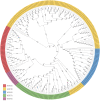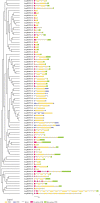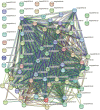Genome-wide analysis and characterization of HSP gene families (HSP20, HSP40, HSP60, HSP70, HSP90) in the yellow fever mosquito (Aedes aegypti) (Diptera: Culicidae)
- PMID: 38102758
- PMCID: PMC10724114
- DOI: 10.1093/jisesa/iead114
Genome-wide analysis and characterization of HSP gene families (HSP20, HSP40, HSP60, HSP70, HSP90) in the yellow fever mosquito (Aedes aegypti) (Diptera: Culicidae)
Abstract
The heat shock protein (HSP) gene families, present across prokaryotes to eukaryotes, play vital roles in growth, development, and heat resistance processes. While HSP proteins have been identified and characterized in various species, this study achieved the first genome-wide identification and characterization of HSP proteins in the Aedes aegypti genome. This study identified and assessed 80 potential HSP genes in Ae. aegypti. The phylogenetic relationships of HSP genes were investigated in Ae. aegypti, Anopheles stephensi, and Drosophila melanogaster. Additionally, the structural features, chromosomal locations, protein characteristics, 3D structure, protein-protein interactions, and microsatellites associated with HSP proteins were examined in Ae. aegypti. The phylogenetic analysis of HSP gene families revealed distinct intra-group relationships for each HSP group. Each family exhibited relatively conserved genetic structures and motif components. In the expression analysis of growth and development, high expression was observed in certain HSP20 and HSP70 genes, while others exhibited low expression. Notably, sex-dependent expression differences were observed, particularly in HSP20 genes. These findings, the relationships, evolution, and modification of HSP gene families are illuminated by these comprehensive findings, and a better understanding of the mechanisms underlying growth, development, and heat resistance in vector organisms is facilitated.
Keywords: Aedes aegypti; HSP gene family; genome-wide analysis; yellow fever mosquito.
© The Author(s) 2023. Published by Oxford University Press on behalf of Entomological Society of America.
Figures







Similar articles
-
Identification and characterization of heat shock 70 genes in Aedes aegypti (Diptera: Culicidae).J Med Entomol. 2009 May;46(3):496-504. doi: 10.1603/033.046.0313. J Med Entomol. 2009. PMID: 19496419 Free PMC article.
-
HSP superfamily of genes in the malaria vector Anopheles sinensis: diversity, phylogenetics and association with pyrethroid resistance.Malar J. 2019 Apr 11;18(1):132. doi: 10.1186/s12936-019-2770-6. Malar J. 2019. PMID: 30975215 Free PMC article.
-
Computational genome-wide identification of heat shock protein genes in the bovine genome.F1000Res. 2018 Sep 20;7:1504. doi: 10.12688/f1000research.16058.1. eCollection 2018. F1000Res. 2018. PMID: 30542619 Free PMC article.
-
Expression of heat shock proteins (HSPs) in Aedes aegypti (L) and Aedes albopictus (Skuse) (Diptera: Culicidae) larvae in response to thermal stress.Acta Trop. 2017 Mar;167:121-127. doi: 10.1016/j.actatropica.2016.12.017. Epub 2016 Dec 24. Acta Trop. 2017. PMID: 28024869
-
Changes in skeletal muscle heat shock proteins: pathological significance.Front Biosci. 2001 Jan 1;6:D12-25. doi: 10.2741/liu. Front Biosci. 2001. PMID: 11145923 Review.
Cited by
-
Genomic Functional Analysis of Novel Radiation-Resistant Species of Knollia sp. nov. S7-12T from the North Slope of Mount Everest.Microorganisms. 2024 Aug 23;12(9):1748. doi: 10.3390/microorganisms12091748. Microorganisms. 2024. PMID: 39338423 Free PMC article.
-
A statistical mechanics investigation of unfolded protein response across organisms.Sci Rep. 2024 Nov 12;14(1):27658. doi: 10.1038/s41598-024-79086-8. Sci Rep. 2024. PMID: 39532983 Free PMC article.
-
Genome-Wide Identification and Characterization of Heat Shock Proteins in the Stored-Product Pest Rhyzopertha dominica (Fabricius): Phylogenetic, Structural, and Stress-Induced Expression Analyses.Insects. 2025 Jan 28;16(2):127. doi: 10.3390/insects16020127. Insects. 2025. PMID: 40003757 Free PMC article.
-
Integrated mRNA and miRNA Omics Analyses Reveal Transcriptional Regulation of the Tolerance Traits by Aquatica leii in Response to High Temperature.Insects. 2025 Mar 18;16(3):316. doi: 10.3390/insects16030316. Insects. 2025. PMID: 40266797 Free PMC article.
References
MeSH terms
Substances
LinkOut - more resources
Full Text Sources
Research Materials
Miscellaneous

